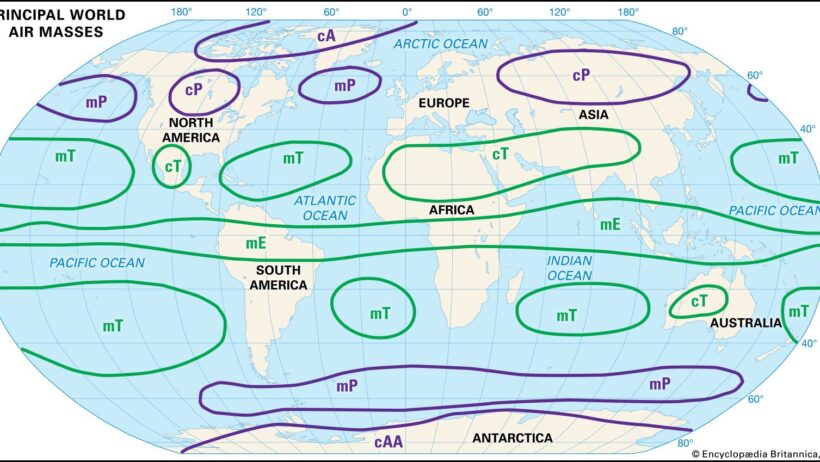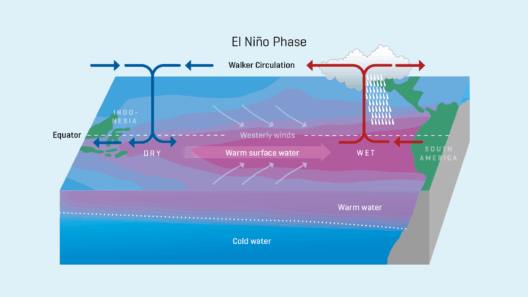The Earth’s climate is a complex tapestry, woven from myriad threads that include air masses, local weather systems, and global atmospheric patterns. Among these, the movement of air masses plays a pivotal role in shaping weather phenomena and consequently, influences broader climate dynamics. Understanding the intricate relationships between these moving entities and their climate implications is vital for grasping the broader narrative of climate change.
Air masses are large bodies of air that exhibit uniform temperature and humidity characteristics. They form over specific regions, acquiring distinct properties from the surfaces beneath them. These air masses can be categorized based on their source regions and thermal characteristics; the most common types include maritime tropical (mT), continental tropical (cT), maritime polar (mP), and continental polar (cP). Each type bears specific traits affecting weather conditions and climate.
Maritime tropical air masses, for instance, originate over warm ocean waters, bringing moisture and warmth when they move inland. This leads to humid, often stormy conditions, particularly in coastal areas. Conversely, continental polar air masses, which form over cold landmasses, bring dry, cold air. When these contrasting air masses collide, the results can be dramatic—think blizzards, thunderstorms, or even tornadoes, depending on the season.
The boundaries between different air masses are known as fronts. These fronts can be cold, warm, occluded, or stationary, each presenting unique meteorological phenomena. A cold front, for example, advances rapidly and can lift warm air, resulting in severe thunderstorms and heavy precipitation. Warm fronts, on the other hand, advance more gently, leading to gradual temperature increases and prolonged rainfall. Understanding these fronts is essential to predicting weather patterns accurately.
As air masses shift, they carry heat and moisture across vast distances, playing a significant role in energy distribution on the planet. This movement of air is not just a local phenomenon; it has global ramifications. The transfer of air masses can influence regional climates and weather patterns far away from their origin. For instance, when warm, moist air from the tropics is transported northward, it can significantly affect climate conditions in mid-latitude regions, often resulting in unusual weather patterns.
The impact of moving air masses on climate cannot be overstated, especially in the current context of climate change. The destabilization of traditional weather patterns can be attributed to rising global temperatures, which alter the behavior of these air masses. Warmer temperatures can lead to more frequent and intense air mass interactions, resulting in extreme weather events. This is particularly visible in the increasing frequency of hurricanes, torrential rainfall, and heatwaves, underscoring the necessity of comprehending these atmospheric shifts.
Climate change dramatically influences how air masses interact. The warming Arctic, for instance, is altering the path of the jet stream, a fast-flowing air current in the atmosphere that guides weather systems. When the jet stream becomes wavier or slows down, it can lead to prolonged periods of heat or cold in certain areas, often intensifying the severity of weather events. Areas that once enjoyed temperate climates may find themselves facing unprecedented heat, flooding, or frost.
Furthermore, the melting of polar ice caps and glaciers releases significant amounts of freshwater into the ocean, impacting oceanic currents and, in turn, altering atmospheric patterns. These changes can disrupt traditional ocean-atmosphere interactions, causing shifts in storm tracks and exacerbating the occurrence of extreme weather events. For instance, warmer ocean temperatures can lead to enhanced hurricane intensity, affecting coastal cities and ecosystems.
As air masses continue to shift, ecological systems are also at risk. Changes in weather patterns can lead to droughts, impacting agricultural production and food security. For instance, changes brought on by climate change can affect the timing of seasonal weather patterns, like rainy or dry seasons, posing challenges for farmers who rely on predictable weather. In some regions, these challenges could lead to crop failures, threatening livelihoods and exacerbating food insecurity.
The far-reaching effects of moving air masses on human populations can no longer be ignored. Communities across the globe may face displacement as climate-induced weather events become more severe. For coastal regions, rising sea levels threaten to submerge land, while those in arid areas may confront increasing desertification and heat, making habitation difficult or impossible.
Adaptation measures are essential to mitigate these impacts. Communities must prioritize resilience, employing sustainable agricultural practices, investing in flood defense infrastructure, and enhancing emergency preparedness. Moreover, there is a pressing need to transition to renewable energy sources to reduce greenhouse gas emissions, limiting the extent of climate change and its effects on air mass dynamics.
The interaction of air masses and climate is a fluid, dynamic system that requires rigorous study and understanding. As air masses continue to shift under the influence of climate change, the necessity for research, adaptive strategies, and sustainable policies becomes paramount. There is an urgent need for global cooperation, as the changes in our atmosphere are not bound by borders. Every individual has a role to play in mitigating the impact of climate change and promoting a sustainable future.
As we navigate the uncertainties posed by shifting air masses and their climate ramifications, an informed and proactive approach will empower society to forge a path toward resilience and sustainability. Wind indeed brings change; however, it is up to humanity to harness that momentum for the health of the planet and all its inhabitants.






